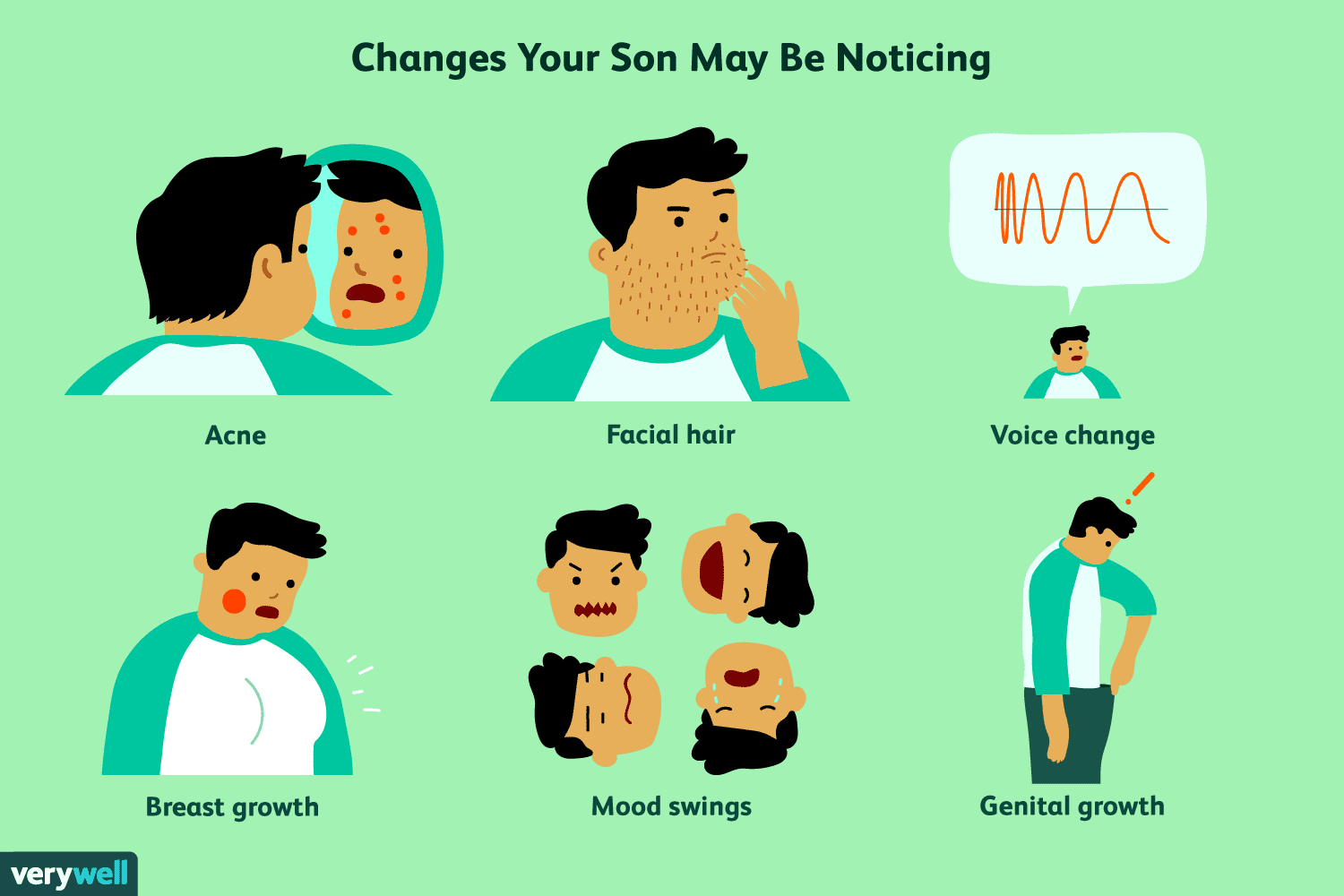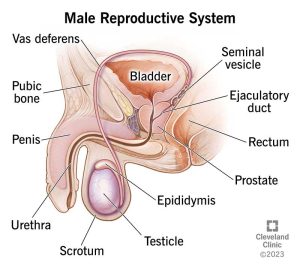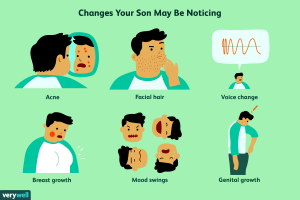Changes during puberty


Puberty
Structure of genital organs, changes during puberty, masturbation. Psychological characteristics specific to different ages: adolescence, youth, and adulthood.
The anatomy of the male reproductive organs. Male and female genitals are internal and external.
The male external genitalia consist of:
- Penis: Comprising of two parts, the penis consists of a spongy body and a glans. At the tip of the penis, there’s a small opening responsible for releasing sperm and urine from the body. The penile tissue is spongy, allowing it to expand and contract. The penis is covered in infancy by a protective skin layer known as the foreskin.
- Scrotum: A skin pouch that holds the epididymis and testicles. It maintains a lower temperature than the body (around 32 degrees Celsius), creating an ideal setting for sperm production. The scrotum’s size adapts based on temperature: expanding in warmth to prevent overheating and contracting in cold temperatures to preserve warmth. Besides its role in temperature regulation, the scrotum acts as a protective shield, safeguarding the testicles from impacts.
- Testicles: Situated within the scrotum, the testicles produce and store numerous microscopic sperm cells. Beyond their reproductive role, they also play a part in the endocrine system by producing hormones such as testosterone. To prevent discomfort and ensure freedom of movement, one of the testicles typically hangs lower than the other.
- Epididymis: Comprising a bundle of tubes that connects with the vas deferens.

Male internal genitalia consist of:
- Vas deferens: It is a muscular tube extending alongside the testicles. The vas deferens is where the sperm passes before ejaculation.
- Urethra: The urethra is the passage through which sperm and urine are expelled from the penis.
- Seminal vesicles: These are the reservoirs of sperm connected to the vas deferens and situated near the bladder. The seminal vesicles generate a fluid that sustains the viability of sperm.
- Prostate: Positioned between the bladder and the penis, the prostate produces a fluid which, upon ejaculation, merges with sperm to form semen. This combined fluid is then expelled from the penis. Both the testicles and the prostate contribute fluids that sustain the viability of sperm.
- Bladder It serves as a reservoir for urine storage.
Changes during puberty

Many physiological and psychological transformations characterize puberty. Secondary sexual characteristics emerge during puberty. The onset of puberty varies among children, starting as early as age nine and extending up to 18-20 years. The typical onset of puberty for boys falls within the range of 10 to 12 years. At this stage, the testicles and scrotum start to undergo development, marking the initial indicator of puberty. The scrotum’s skin begins to redden and crease, and the testicles commence sperm production alongside the hormone testosterone. This hormone is pivotal in stabilizing male puberty and facilitating penile erection. Under the influence of testosterone, hair also begins to grow in the groin region.
Around a year after the onset of testicular changes, boys commonly experience a swift growth spurt, typically between the ages of 13 and 14. The initial signs of facial hair become noticeable near the upper lip, typically between the ages of 14 and 17, leading to the eventual development of a mustache. Following these initial changes, hair growth begins on the upper part of the cheeks, followed by the lower part of the lower lip. After that, hair appears on the chin and various other regions of the face, and eventually, a beard develops on the lower portion of the face. The sequence of these transformations varies and is unique to each individual due to biological processes. By late adolescence, around the ages of 17 to 18, a well-developed facial hair pattern is typically established.
Throughout adolescence, increased sweating occurs, accompanied by heightened skin and hair oiliness, contributing to acne on the face, shoulders, and back. Noticeable weight and height gains occur, with shoulders broadening and chest circumference expanding as muscles develop. Hair coverage proliferates, encompassing the face, chest, underarms, hands, and feet. Another distinctive change during this phase is the deepening of the voice, accompanied by the increased prominence of the Adam’s apple on the neck. Between the ages of 16 to 18, the penis experiences lengthening and thickening, coinciding with the establishment of sperm production. During male puberty, a phenomenon known as “wet dreams” refers to spontaneous ejaculations during sleep.
This occurrence results from the onset of sex hormone production in boys during puberty, leading to the formation of sperm expelled from the body. This process can occur during sleep and may also be accompanied by erotic orgasms, during which ejaculation occurs. During this stage, it’s common for the penis to experience erections, often occurring in the morning or throughout the day. Wet dreams typically commence during puberty and exhibit significant individual variation; some individuals may experience them daily, while others infrequently, both natural. This phenomenon can persist throughout a person’s life and become less frequent once a man becomes sexually active.
Masturbation
Masturbation is deliberately stimulating one’s genitals for pleasure and personal comfort. This natural behavior is part of self-awareness and typically emerges young. Its primary intention is self-discovery. Frequency can vary significantly, with some individuals engaging in it multiple times a day while others do so once a week. Increased frequency might be linked to psychological factors such as fears, anxieties, or a tense family environment. Masturbation tends to become more frequent during adolescence as individuals begin to experience sexual desires that might not necessarily be fulfilled through sexual intercourse.
This practice holds particular significance during this phase because:
- Adolescents develop an understanding of their bodies and how they function.
- When parents react positively, it helps the adolescent appreciate their body without feelings of shame.
- It can assist in alleviating sleep issues and tension.
- It contributes to developing self-awareness and recognizing personal needs, which can enhance future sexual experiences in enjoyment and fulfillment.
When it comes to seeking professional assistance, there are several factors to consider:
- If masturbation has started to dominate a significant portion of an individual’s daily routine.
- It might be inappropriate when it’s practiced in the presence of others.
- If masturbation continues extensively into adulthood without being balanced by sexual intercourse, or if a person struggles to derive enjoyment from sex while finding it satisfying during masturbation.
Remember that masturbation is a natural occurrence in the lives of both males and females. Engaging in masturbation does not jeopardize future sexual relationships with a partner or lead to any physical or mental health issues.
Psychological characteristics specific to different age groups: adolescence, youth, and adulthood.
Adolescent Crisis
The onset and culmination of the adolescent crisis vary individually, from 8 to 15 years old. During this phase, the child’s entire organism undergoes a crisis marked by physical transformations, changes in appearance, and significant psychological shifts. This age serves as the commencement of forming one’s sexual identity, leading the individual to view themselves as a participant in sexual activity.
This juncture is characterized by the following observations, primarily among adolescents:
- Reduced motivation for learning,
- Aspiration to attain adulthood and assert newfound rights,
- Friction and disputes with parents and teachers,
- Demonstrations of protest and rebellious behavior,
- Sensations of inadequacy or incompleteness,
- Periods of depression,
- Instances of anxiety,
- Intense focus on reflective questions like: “Who am I?”, “Why was I born?”, “Am I attractive or unattractive?”
Considering that puberty aligns with the adolescent crisis, adolescents focus on their appearance due to the bodily changes they experience. The development of self-awareness becomes a crucial process during this period, marked by significant uncertainty and confusion. Peers begin to assume a pivotal role at this stage, contributing substantially to shaping the adolescent’s sense of self and self-awareness. A distinctive feature of the adolescent crisis is the perception of maturity. Adolescents start to place value on their peers while simultaneously relying on adults and realizing their lack of complete readiness to handle many decisions and life challenges. They compare with adults, recognizing their similarities and feeling the urge to shed the “child” label, striving for equal rights. They yearn to emulate adults, often adopting external markers such as alcohol, smoking, specific language, fashion, etc.
Adolescents may allocate substantial time to caring for loved ones and participating in and assisting adults. Simultaneously, they cultivate a desire to acquire knowledge and skills. This aspiration serves as a motivation for their self-development, encouraging cognitive endeavors beyond the confines of the school curriculum.
The paradox of the adolescent crisis lies in the adolescent’s huge sense of maturity, juxtaposed with their not-yet-complete maturity. This situation compels them to navigate the exploration of their place, role, and significance within their world.
Adolescent Crisis
The adolescent crisis comprises two distinct components: early adolescence (ages 15 to 17) and late adolescence (ages 17 to 23).
During early adolescence, which aligns with the final years of school, the child confronts the pivotal decision of shaping their future life and profession. This juncture brings about a blend of apprehension due to the uncertainty of what lies ahead, coupled with adult expectations. Consequently, a fear of an uncertain future starts to take root. Simultaneously, concerns regarding self-worth begin to escalate.
In this phase, the foremost focus centers on their professional trajectory and self-identity. Interpersonal relationships and connections within the family lose some significance. Nevertheless, recognizing a dependable adult’s role gains importance as they transition toward late adolescence. During this phase, they value interactions both with adults and peers, yet with the maintenance of certain boundaries. Typically, adults are approached when complex situations arise where autonomous solutions or decisions are challenging, particularly those relating to the future.
As they mature, the desire for social engagement expands, yet satisfying this urge becomes intricate as the expectations increase. The emotional intensity within friendships often mellows in the presence of romantic love. The adolescent’s aspirations for love predominantly reflect a craving for emotional warmth, understanding, and spiritual unity. A preoccupation with the future is a distinctive trait of youth. Young individuals must envision their future in broad strokes and grasp the means necessary for attaining their objectives. The development of self-determination, encompassing both professional and personal realms, is a core facet of adolescence.
As one reaches the final year of school, tension tends to heighten. The pivotal decision looms palpably close. Among high school students, varying patterns emerge. Some maintain an optimistic self-esteem that, while not excessively high, harmoniously aligns desires, ambitions, and self-assessment. Others exhibit lofty and comprehensive self-esteem, encompassing all facets of life.
Conversely, some individuals manifest a sense of mistrust, with their self-esteem being low and conflicted. Changes in self-esteem can lead to an escalation of anxiety. Overall, a general sense of stabilization characterizes individuals at this stage as they begin to embrace themselves more and cultivate a generally elevated self-esteem. The development of self-regulation gains momentum, leading to heightened control over behavior and emotions. This process intertwines with the emergence of moral steadfastness, marked by a focused alignment with one’s views and beliefs.
This phase marks a farewell to childhood, positioning individuals on the cusp of adulthood. Adolescence encompasses profound changes in boys’ lives, including admission to higher education institutions and potentially military service. Escapes from societal norms towards drug use or religious groups occasionally surface during this period. It’s crucial to exercise caution to ensure these escapes don’t take precedence, as they could elevate the risk of school and work dropout. Such escapes might stem from heightened uncertainty, a sense of emptiness following the conclusion of childhood, or the struggle to identify life’s purpose. If the future remains unclear for youth, they might seek refuge from boredom, pursuing novel experiences. Tragically, this can escalate to the point of suicide.
Crisis in the 25-33 Age Range
The ages 25 to 33 period is characterized by two contrasting tendencies: closeness and isolation. During this phase, individuals are willing to establish relationships that demand a degree of self-neglect. Marital bonds stand out prominently among such relationships. Conversely, the hazard of this stage lies in isolation, where individuals shy away from connections that entail intimate relationships. This avoidance stems from a perceived threat to one’s sense of self, a fear of losing oneself or ceding control of the “space” within their relationship to another.
A crisis often surfaces for most individuals around 30, sometimes even slightly later. This crisis manifests as reevaluating one’s perceptions regarding life, values, aspirations, dreams, worldview, interpersonal connections, and a marked shift in professional orientations. The urgency of career development becomes particularly pronounced for both men and women. A profound desire to reset one’s past and start anew at age 30 emerges. This phase prompts endeavors to introduce changes in personal life, such as marriage and parenthood, although divorces also become more frequent during this period. The crisis at the age of 30 arises from unfulfilled life plans. However, when one’s life path is chosen appropriately, attachment to specific activities, lifestyles, values, and orientations not only doesn’t confine them but rather fosters personal growth.
The primary indicators of this crisis encompass a reevaluation of prior values, shifts in goals and interests, a sense of decline and disillusionment, self-doubt, feelings of inadequacy, and an intense pursuit of self-awareness. Hypersensitivity regarding career advancement, the decision to have or raise children, and more also often characterize this phase.
Referred to as the crisis of meaning, the 30-year crisis is frequently associated with the search for existence. Like other crises, this quest signifies the transition from youth to maturity.
